Q1. Every village in India is surveyed once in ten years during the Census and some of the details are presented in the following format. Fill up the following based on information on Palampur.
(a) Location
(b) Total Area of The Village
(c) Land USE (in hectares)
(d) Facilities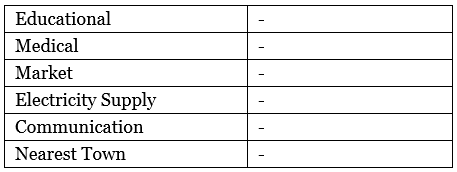
Ans:
(a) Location: Bulandshahar district, Western Uttar Pradesh
(b) Total Area of The Village: 226 hectares
(c) Land USE (in hectares):
(d) Facilities: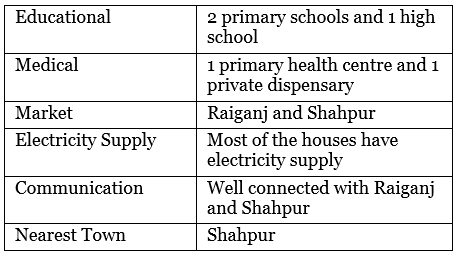
Q2. Modern farming methods require more inputs which are manufactured in industry. Do you agree?
Ans:
- Traditional farming methods involve the use of relatively low-yielding seeds, which require less water for irrigation.
- Farmers following the traditional methods use cow dung and other natural manure as fertilizers.
- All these elements are readily available to the farmers. This makes them less dependent on industrial output.
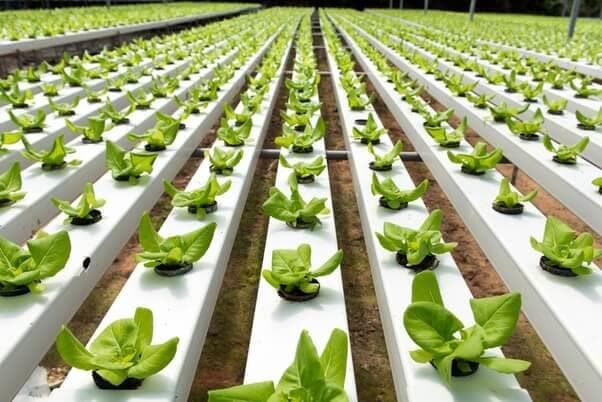 Modern Farming Method
Modern Farming Method - Modern farming methods, on the other hand, involve the use of high-yielding variety seeds.
- These seeds require a combination of chemical fertilizers and pesticides, agricultural implements like tractors, and proper irrigation facilities like electric tube wells to produce the best results.
- All these elements are manufactured in industries. Hence, it would be right to say that modern farming methods make use of a greater number of industrial outputs as compared to traditional farming methods.
Q3. How did the spread of electricity help farmers in Palampur?
Ans: The spread of electricity helped the farmers in Palampur in the following ways:
- Most of the houses have electricity connections.
- It is used to run tube wells in the field.
- It is used in various types of small businesses.
Q4. Is it important to increase the area under irrigation? Why?
Ans:
- Monsoons are by their very nature erratic and variable. So, farming cannot entirely depend upon rains. Increasing the area under irrigation.
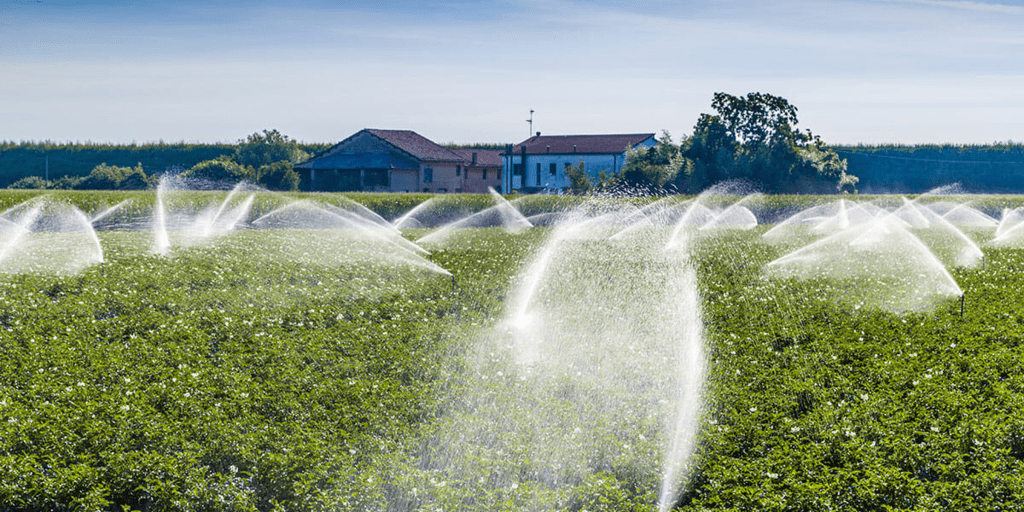 Modern Irrigation Method
Modern Irrigation Method - A large portion of the cultivable land in India is not well irrigated and is dependent entirely upon rains.
- As a result, when rains are late or are inadequate, farmers incur much loss. The loss is more acutely experienced by the small farmers.
- Failure of rain means failure of crops and a total waste of efforts and resources, both for the individual farmers and for the economy.
- To avoid such situations, it is important for the entire cultivable area of the country to be brought under the protective shield of proper irrigation facilities.
- A well-irrigated land produces greater output.
- The constant availability of water for irrigation provides a sense of stability to the farmer and also encourages him to practice newer farming methods and patterns to maximize the productivity of his land.
Q5. Construct a table on the distribution of land among the 450 families of Palampur.
Ans: Distribution of land among 450 families of Palampur is as follows:
Q6. Why are the wages for farm labourers in Palampur less than minimum wages?
Ans: The wages for farm labourers in Palampur are less than the minimum wages because:
- There is heavy competition for work among the farmers.
- Employment is less and farmers are more and, therefore, farmers have to be content with what they are earning.
- Land is owned by landlords who desire to earn more and more profit by giving minimum wages.
- The farmers are illiterate and unaware of the amount of minimum wages set by the government.
Q7. In your region, talk to two labourers. Choose either farm labourers or labourers working at construction sites. What wages do they get? Are they paid in cash or kind? Do they get work regularly? Are they in debt?
Ans:
- There is a gym and a swimming pool under construction in our colony. On speaking with Masud and Rehman, two construction labourers, I understood that they get about 80-90 rupees per day for their labour.
- The two labourers belong to the Basti district of Uttar Pradesh and they had migrated to Delhi to work as labourers on daily wages. Their work is not permanent.
- They do not get regular work. They are always paid in cash by the contractor who hires them for work.
Q8. What are the different ways of increasing production on the same piece of land? Use examples to explain.
Ans: The land area under cultivation is practically fixed so in order to increase the production from the same piece of land, we can use the following methods:
(a) Multiple Cropping
- It is the most common way of increasing production on a given piece of land. It means when two or more crops are grown on the same piece of land during a year, i.e., Indian farmers should grow at least two main crops in a year.
- In India, some farmers are growing the third crops also over the past 20 years as in Palampur jowar and bajra are grown and potato is the third crop.
(b) Modern Farming Methods
- Production on the same piece of land can also be increased by adopting modern fanning methods.
- The Green Revolution in India is a remarkable example of it. Under modern farming, more cultivable area should be brought under high yielding varieties of seeds and irrigation.
- The use of simple wooden plough must be replaced by tractors and with increased use of farm machinery such as tractors, thrashers, and harvesters, make cultivation faster and also help in increasing yield per hectare.
Q9. Describe the work of a farmer with 1 hectare of land.
Ans: A farmer who works on 1 hectare of land is called a small farmer.
He carries out the following activities:
- Ploughs the field by bullocks or tractors.
- Sows the seeds by simply sprinkling with hands.
- Waters the field with the help of the Persian wheel.
- Sprays the insecticides with manual pumps.
- Cuts the crops with hand-operated tools.
Q10. How do the medium and large farmers obtain capital for farming? How is it different from the small farmers?
Ans:
- Medium and large farmers retain a part of their produce and sell the surplus in the market.
- This provides them with the required capital for farming. Most of them even use these earnings to provide loans to small farmers.
- By charging high rates of interest on these loans, they succeed in furthering their earnings.
- Thus, medium and large farmers have ready capital with them from one agricultural season to the next.
- The situation of small farmers is in stark contrast. They begin an agricultural season with no working capital and end the season on more or less the same note.
- To begin working on their farms, they take loans at high rates of interest. Due to the small sizes of their farms, their total production is small.
- Their produce is kept for their needs or for repaying their lenders. As a result, they have no surplus to sell in the market, and thus, have no savings.
Q11. On what terms did Savita get a loan from Tejpal Singh? Would Savita’s condition be different if she could get a loan from the bank at a low rate of interest?
Ans: The terms of a loan of Savita taken from Tejpal Singh are:
- She took a loan of Rs. 3,000 at an interest rate of 24 per cent.
- She would have to repay the loan in four months.
- She also has to work on Tejpal’s field as a farm labourer during the harvesting season at Rs. 100 per day.
The bank could have provided her loan at a low rate of interest. In addition, she would have devoted more time to her own field of 1 hectare, instead of working as a farm labourer for Tejpal Singh.
Q12. Talk to some old residents in your region and write a short report on the changes in irrigation and changes in production methods during the last 30 years.
Ans:
(a)
- On talking to two old residents Ramlal and Dharam Singh, I came to know about the irrigation methods that were traditionally in use in our area.
- They told me that earlier they were dependent on rainfall and later on they started to use the Persian wheel to draw water from the wells.
- With the development of technology, tube wells were used for better and effective irrigation.
(b)
- In the farming methods, traditionally they ploughed the field with ploughs drawn by bullocks which were a very difficult and time-consuming process.
- They used ordinary seeds and cow dung manure for fertilization.
(c)
- However, with changes in technology, the farmers started using HYV seeds, chemical fertilizers, insecticides, pesticides and modern machinery like tractors and threshers.
- Which has led to an increase in yield per hectare and improved the lives of the farmers.
Q13. What are the non-farm production activities taking place in your region? Make a shortlist.
Ans:
- Dairy is a common activity in many families in our region.
- Some people are involved in small-scale manufacturing in their homes or in the field like the production of jaggery by Mishrilal.
- A few people are involved as shopkeepers and traders who buy various goods from the wholesale market in the cities and sell them in the villages.
- Some people near the bus stand have opened shops selling eatables.
- Some people are in the transportation sector, ferrying people and carrying goods from one place to another in different types of vehicles.
- People like Kareem opened a computer class centre and also provided employment to two women who had a diploma in computer application.
Q14. What can be done so that more non-farm production activities can be started in villages?
Ans: Three things that need to be done to encourage non-farm production activities in villages:
- The government should set up schemes whereby landless labourers and small farmers are able to get cheap loans to start small individual/community businesses.
- In addition to financial assistance, the government should set up rural workshops to enable the villagers to build on their skill levels.
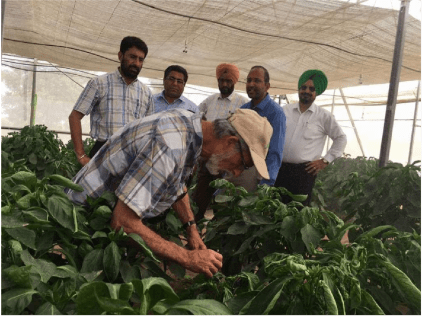 Rural Workshop
Rural Workshop - The government should also work towards improving the infrastructure of villages so that the rural parts of the country are well connected to the urban areas.

No comments:
Post a Comment